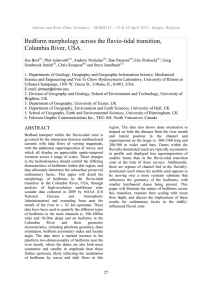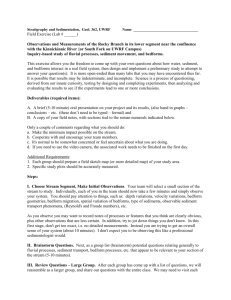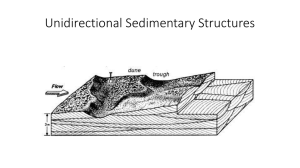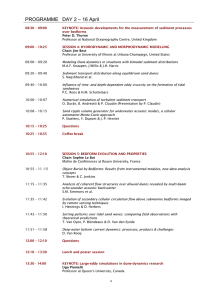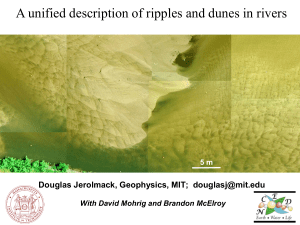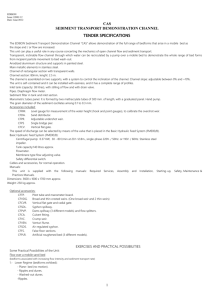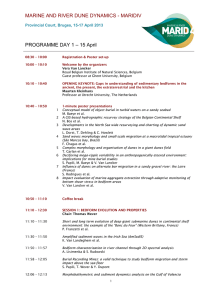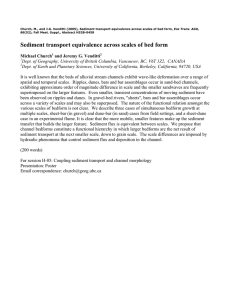Low Froude Number Bedforms
advertisement
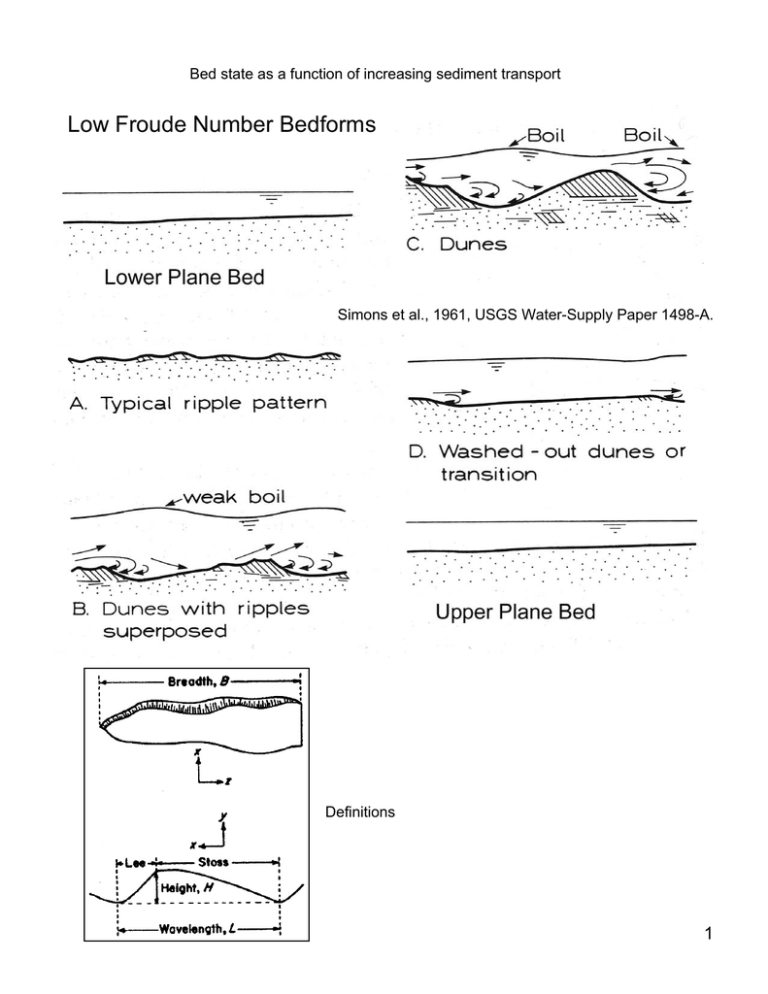
Bed state as a function of increasing sediment transport Low Froude Number Bedforms Simons et al., 1961, USGS Water-Supply Paper 1498-A. Definitions 1 Lower Plane Bed Low transport stages: T = τsf/τcr < 5 Approximately planar surfaces: grain transport a mixture of rolling and saltation. also, typically low sediment supply rates. Surface development sensitive to local bedload supply from upstream being equal to or less than ability of the flow to transport that load. Lower Plane Bed where gravel fraction << sand fraction Gravelly streaks mantling top of sandy bar (some dunes are also present) field of view approximately 15m × 15m Streakiness results from particle segregation by vortexes elongated in the direction of the flow. [Mixture of streaks (lower plane bed) and ripples on bar top, meter stick for scale] Ripples: Low Froude number, asymmetric bedforms that are built out of grains being transported almost purely as bedload. The characteristic length of ripples has been proposed to scale with grain size, with L ≅ 1000d, where d is particle diameter. This relationship is somewhat controversial. Another commonly cited criterion for ripples is L < 0.6m. This length criterion assumes that ripples do not form in sediment that is coarser-grained than sand. Again, controversial. Ripples are reported built out of granules, pebbles and in extreme cases, cobbles and boulders. Typical ripple values for the ratio L/H range from 8 to 15. [Train of ripples on a bar top. Wind waves are interacting with the ripple forms. Meter stick for scale.] 2 Dunes: Low Froude number, asymmetric bedforms that are built out of grains being transported both as bedload and suspended load. Notice ripples on the backs of dunes. Superimposed or compound bedforms are common. Notice inconsistency with many bedform phase diagrams. Exception is work by Rubin & McCulloch (1980, Sedimentary Geology, v. 26, 207-231). They propose small bedforms can exist in equilibrium on the larger bedforms because the large bedforms generate boundary layers in which the small bedforms are locally stable. 3 e om l Po e iv R t r Laboratory data th or N up Lo er iv R us m a al C e iv R r [Triangles and dashed line are data from three rivers with depths of flow up to 2.5m. Solid line and shaded area (± one standard deviation) summarize data from flume studies with depths of flow < 0.5m.] Dune length is often described as a function of flow depth because in many cases dune height is limited by flow depth. (Remember: dune lengths are related to their heights. Typical dune values for the ratio L/H range from 15 to 25.) River Data: Gabel, S.L., 1993, Geometry and kinematics of dunes during steady and unsteady flows in the Calamus River, Nebraska, USA: Sedimentology, v.40, p.237-269. Korchokha, Y.M., 1968, Investigation of the dune movement of sediment on the Polomet River: Soviet Hydrology: Selected Papers, AGU, n. 6, p. 541-559. Mohrig, unpublished data, N. Loup River. Lab Data: Stein, R.A., 1965, Laboratory studies of total load and apparent bed load: Journal of Geophysical Research, v.70, p.1831-1842. Guy, H.P., Simons, D.B., and Richardson, E.V., 1966, Summary of alluvial channel data from flume experiments, 1956-61: United States Geological Survey Professional Paper 462-I, 96p. 4 2D versus 3D bedforms: 1) Fluid mechanical criterion is whether the vortex over lee face of bedform is continuous along the crest or broken at quasi-regular intervals. 2) Geometric criterion is whether the flow depth is relatively constant following a bedform trough or irregular with scour pits at quasi-regular spacing. [2D bedforms and stratification on top, 3D bedforms and stratification below] 5 Characteristic excursion length for particles is an important parameter for determining bedform geometry from inception to washout. [Characteristic trajectories for grains moving as bedload (Type 1) and suspended load (Type 2)] Washout of a bedform begins when the characteristic excursions lengths for a significant number of size classes become long relative to the distance of the lee face. These particles bypass the lee slope and, therefore, are not incorporated into the bedform. Dune washout and the transition to upper plane bed. [Data from flume studies.] Transition from Bedforms to Upper Plane Bed: Bed condition where excursion lengths for particles become long and bedforms become sediment starved. The washout of bedforms typically involves a reduction in height and a relative increase in the L/H ratio, which acts to further reduce their height. Under these conditions the dominant mode of sediment transport is suspended load. Lab Data: Stein, R.A., 1965, Laboratory studies of total load and apparent bed load: Journal of Geophysical Research, v.70, p.1831-1842. Guy, H.P., Simons, D.B., and Richardson, E.V., 1966, Summary of alluvial channel data from flume experiments, 1956-61: United States Geological Survey Professional Paper 462-I, 96p. 6 High Froude Number Bedforms 5m Simons et al., 1961, USGS Water-Supply Paper 1498-A. Aerial view of standing waves in channels. 0.1 m View through sidewall of flume. Colored water appears black. (image provided by Gary Parker) 7
